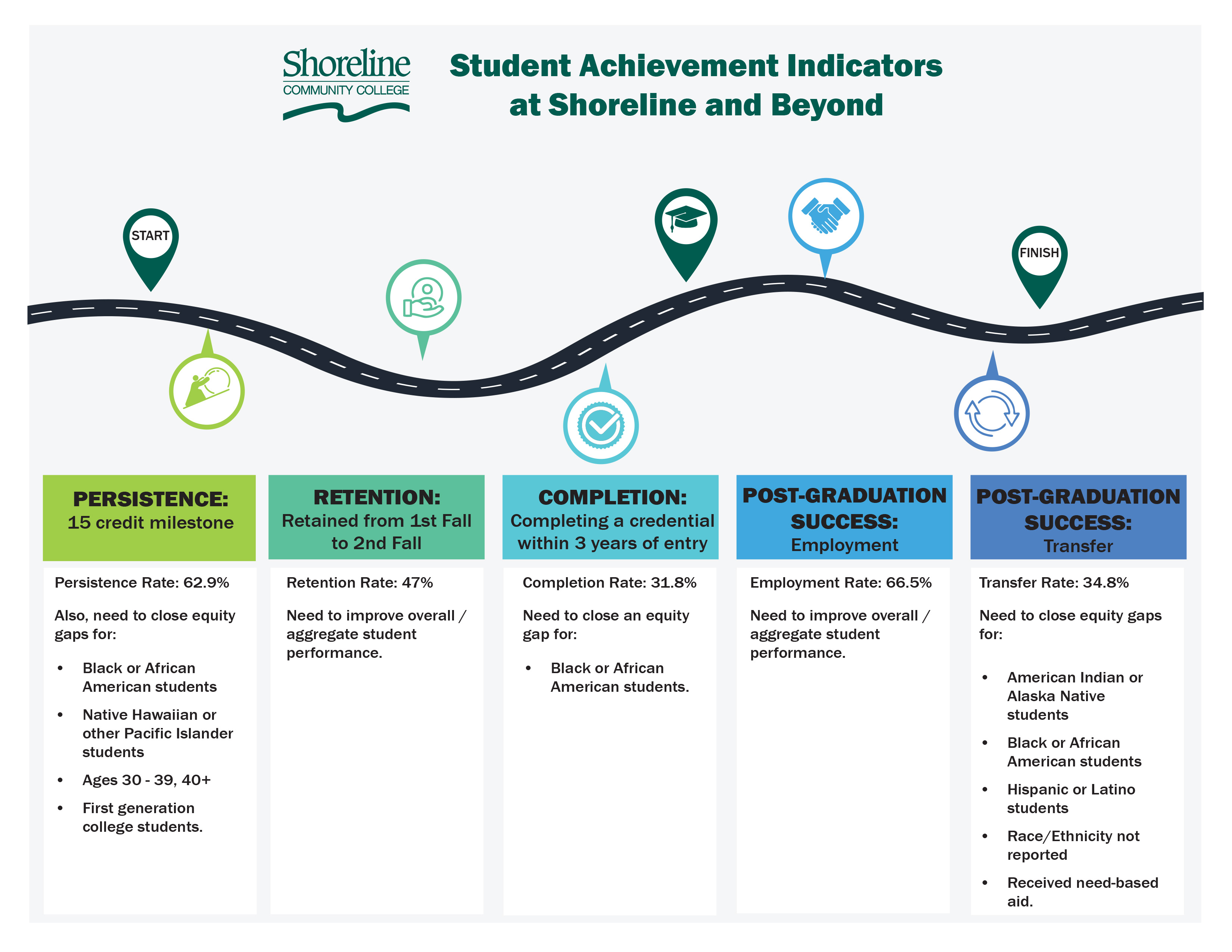Student Achievement Indicators

Shoreline Community College benchmarks our students' achievements against three regional peers and two national peers. Regional peers include North Seattle College, Skagit Valley College, and South Puget Sound Community College; they were selected based on comparable size (FTEs), comparable mix of instructional program offerings (mix of transfer and professional/technical programs), and comparable student demographics. National peers include Diablo Valley College and Orange Coast College, both in California; they were selected based on the size of their international student programs. . One peer’s international program is similarly sized to Shoreline and one is larger than Shoreline and, hence, an aspirational peer college. Both national colleges are much larger than Shoreline overall.
This data is used by the College for continuous improvement of policies, procedures, and practices related to student success. Shoreline sets benchmarks based on the following criteria:
- If Shoreline’s cumulative three-year percentage for a particular benchmark is less than the cumulative three-year percentage of the regional peer group, then the average of the peer group becomes the new target for Shoreline for the duration of the five-year Strategic Plan.
- Progress toward the target will be evaluated in the Fall and the Spring. Years will be scored as either met target (the target has been met), adequate progress (within 5% of target), or needs improvement (more than 5% below target).
- Equity gaps will be evaluated every Spring to assess, improve, or implement new interventions to meet target goals.
- If Shoreline’s cumulative three-year percentage is greater than or equal to the average of the regional peer group, then equity gaps are evaluated. Shoreline evaluates equity gaps both in terms of peer group performance and Shoreline’s overall performance. Interventions are targeted to disaggregated student populations with a gap exceeding 5% of the college average, or a 5% gap between a Shoreline disaggregated population and the corresponding average for the same population for the regional peer group.
- If Shoreline’s cumulative three-year percentage is greater than or equal to the regional peer group average and no equity gap is greater than 5% of the college cumulative three-year percentage or peer group cumulative three-year percentage for the corresponding student population, then the goal is to maintain or exceed the measure.
Data sources include the Washington State Board of Community and Technical Colleges and the College Scorecard data. Data is available at the college level, and disaggregated by race/ethnicity, age, gender, first-generation college student, and whether a student received need-based aid (in alignment with the Northwest Commission on Colleges and Universities (NWCCU) accreditation standard 1.D.2) to identify and close equity gaps and are used to measure progress toward equitable continuous improvement of student success. In keeping with the NNWCCU’s recommended best practices, peer colleges are not explicitly identified and data are presented in aggregate. Disaggregated student categories also suppressed where there are fewer than ten students in order to protect student privacy.
Student Learning: defined as 75% of students meeting expectations related to a Shoreline Student Learning Outcome (SSLO)
Persistence: 15 Credits Milestone: completing the first 15 college-level credits in Year 1
Retention: First Fall to Second Fall: enrolling for the first time in Fall quarter or the Summer preceding, and returning to enroll again in the 2nd year Fall quarter (or completing in the interim)
Completion: completing a credential within three years of entry
Post-College Success: Transfer
Post-College Success: Employment